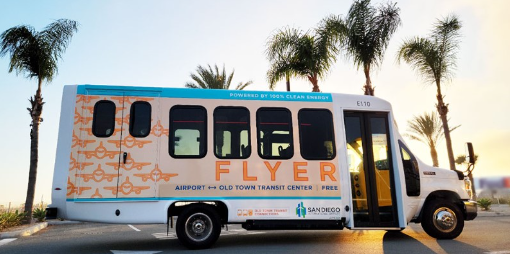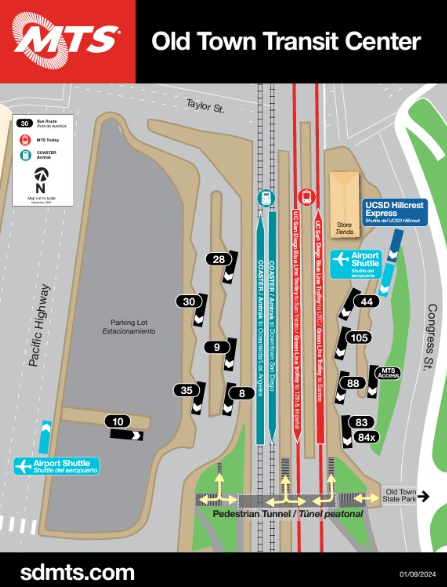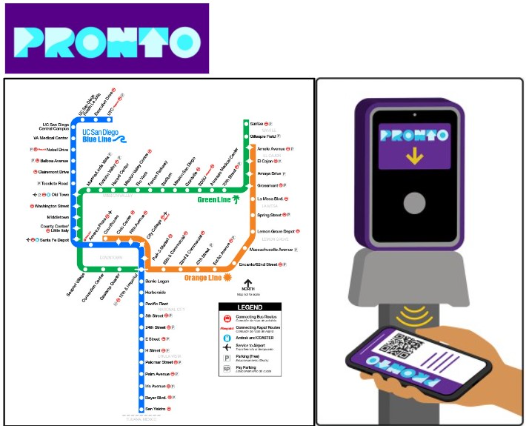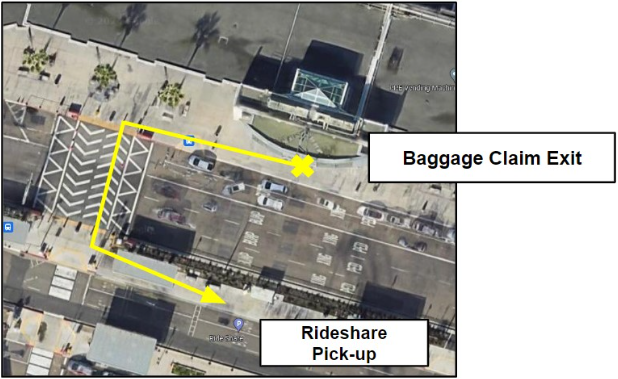Travel Re-entry
When traveling, especially internationally, it is important that you think and plan carefully. Every country has its own laws and documentation requirements when it comes to allowing individuals to enter its borders, and there are many things to keep in mind when you depart and re-enter the U.S.
Please be aware of these requirements, and make sure you carry the proper documents on your person so that you can travel and re-enter the U.S. without problems.
All new students should arrive in San Diego before new student orientation begins. We recommend arriving several days or more before orientation for time to adjust to the new time zone and become familiar with San Diego.
Transportation Options to SDSU
- Public Transportation: After arriving at San Diego international Airport, jump on the San Diego Flyer, a free shuttle to the Old Town Transit Center.

- From the Old Town Transit Center, take the Green Line trolley bound for either Santee or SDSU.

- The trolley fare is $2.50 per ride unless you're 18 years of age or younger.
- To take public transportation in San Diego, you will need to download the Pronto App. You can view the trolley schedule and map here.

-
Uber and Lyft: Remember to download the Uber or Lyft app before your flight.
Designated Rideshare passenger pickup locations at the San Diego International Airport are listed below:-
Terminal 1: Travelers will exit baggage claim, use the new pedestrian crosswalk, with a traffic light to provide access to Ground Transportation resources (VFH, Courtesy, Taxis, Rideshare and RCC). See signage for assistance.
-
Terminal 2: Upon exiting baggage claim, use the main crosswalk to Transportation Plaza. Ridesharing pick-up is located in the second lane on the right. See signage for assistance.
- You can have the rideshare drop you off at one of our campus locations.
-

- Taxi: Taxis are also available from the San Diego International Airport. A one-way fare from the San Diego Airport to SDSU is approximately $50.
Additional transportation options and general information about San Diego International Airport can be found here.
If you are going to live off-campus, information on getting to the SDSU campus and buying a parking permit can be found here.
If you are traveling within the U.S., including Hawaii and Alaska, you do not require a valid U.S. visa or travel signature.
Important documents
- Your passport
- Your most recent I-20 or DS-2019
- Your most recent I-94
Make copies: When you are not traveling, you should keep your important documents in a safe place and also make paper or electronic copies of them.
Local travel
TSA travel guide
The Transportation Security Administration (TSA) has prepared a traveler's guide to help ensure passengers have the answers they need to common security screening questions. Find TSA travel information.
Before you depart the U.S., you should confirm that you have the required documentation to travel to other countries and re-enter the U.S. If you depart the U.S. without a required document or travel signature, you could find that you are unable to re-enter the U.S. until you receive it.
Each country has its own immigration regulations and requirements for individuals entering its borders, and these may differ depending on your citizenship.
The ISC cannot advise you on how to obtain a visa to another country (or whether you need one). For this information, you need to visit the embassy website of the country you plan to visit, and find out:
- What you need to do
- What you need to bring with you
Before departing the U.S. to visit Mexico (includes Tijuana) or Canada, be sure that you have:
- The proper documents to travel in those countries
- The proper documents to return to the U.S., as listed below
Automatic Visa Revalidation
If you have a visa in your passport but it is expired, students from certain countries can travel to Mexico, Canada and adjacent islands for less than 30 days and re-enter the U.S. with an expired visa if you are still in a valid period of study at SDSU or on Post-Completion or STEM OPT. This is called Automatic Visa Revalidation. It is absolutely essential that you have a printout of your recent I-94, your passport, your I-20 or DS-2019, your expired visa, and your EAD card (if on OPT) when traveling to Mexico or Canada. Without these items, you will not be eligible to re-enter the U.S. under automatic visa revalidation.
- Important: If you go to Mexico or Canada and apply for a new U.S. visa, you will not be able to re-enter the U.S. under Automatic Visa Revalidation.
If you are planning to use the automatic visa revalidation, you should talk with an ISC Advisor before visiting Canada or Mexico.
Canadian and Mexican Visa Requirements
- Canada: To find the visa requirements for travel to Canada, visit the website for the Canadian Consulate.
Mexico: To determine if persons from your country need a visa to visit Mexico, check with the Mexican Consulate in San Diego.
Travel alert for Mexico
If you are planning to visit Tijuana or other parts of Baja California, please read the current travel warnings. The U.S. Department of State Travel Alert for Mexico is not meant to alarm you, but to make you aware of the issues regarding violence in Tijuana, and the current risks of travel to Tijuana, northern Baja California, and other parts of Mexico. Students should be careful and aware when travelling in any city or country.
Travel with the Necessary Documents
When you are traveling abroad and planning to re-enter the U.S., please be sure to have the necessary documentation with you.
Keep these documents on your person or in your carry-on bags (if flying) so that they can be accessed when you pass through US Customs. Have them printed and do not rely on electronic versions. Failure to have the required documents could delay your travel plans or prevent you from being able to re-enter the U.S.
Required:
-
Valid passport
-
Most students can renew their passport in the U.S. through their country's embassy or consulate, if needed
-
-
Valid F-1 or J-1 visa
-
If expired, you must renew at a U.S. consulate outside the U.S.
- You cannot renew a visa in the U.S. (see section below: How to renew your visa)
- In certain cases, you might be able to re-enter without a new visa through
-
- Valid I-20 or DS-2019 with valid travel signature
- I-20 signatures are valid for 12 months from the date of signature on page 2 (or 6 months if you are on Post-Completion OPT or the OPT STEM Extension)
- DS-2019 signatures are valid for 12 months from the date of signature
- If you need a new travel signature, please complete the I-20 Replacement/Update Request Form or
DS-2019 Replacement/Update Request Form (found on the ISC's Forms webpage).
-
EAD card (only for students on Post-Completion OPT or the STEM OPT Extension)
-
If Post-Completion OPT application is pending, the I-797 receipt notice should be used. We recommend, however, that you wait until after your OPT is approved and you have the EAD card to re-enter the U.S. If any questions, please consult an ISC advisor.
-
- Most recent I-94
- Print a small version of it and have it with you at all times, even when not travelling
- Admission letter from SDSU
- You received an Admission Letter via email when you were admitted. Locate the email, click to open it in a new window for a neater view and print it
- Most recent unofficial transcript
- You can get this from my.SDSU
- You can get this from my.SDSU
- Course registration information
- For the Summer 2025 semester (if applicable) and Fall 2025
- If you are not yet enrolled in Fall 2025 courses, in my.SDSU print a copy of your Enrollment Appointments page for Fall 2025 that shows the “Appointment Ends” date
- Receipts of payment toward tuition
- Print your Financial Statements for all terms available in your account. You can get this from my.SDSU
- If you have not yet made a payment toward Fall 2025 tuition, print the Fall 2025 Academic Calendar and highlight the Basic Tuition and Fees payment deadline in case you need to show this
Recommended:
- For currently enrolled students:
- Additional proof of enrollment
- Enrollment verification letter, etc.
- Proof of enrollment
- Transcript (available in my.SDSU), enrollment verification letter, etc.
- Proof of funding
- Bank statements, scholarship letter
-
Non-immigrant intent
- Additional proof of enrollment
- For students on Post-Completion OPT or the OPT STEM Extension:
-
Proof of employment
-
Employer pay stubs, job offer letter, letter from employer confirming current employment, or if volunteering a letter from organization/individual that you are volunteering with confirming your volunteer status and details
-
-
Be sure that you have done everything to maintain your F1 immigration status. For Post-Completion OPT, visit the OPT webpage. For OPT STEM Extension, visit the OPT STEM Extension webpage.
-
What is the I-94?
The I-94 is the Arrival/Departure Record issued by the U.S. Customs and Border Protection (CBP) when you enter the United States. You should check your I-94 each time you enter the U.S. to be sure that your entry was recorded for the correct visa type and duration of status.
Most often, the I-94 Arrival/Departure Record record is electronic. However, sometimes it is a paper stapled into your passport when you enter the U.S. (This generally occurs if you enter the U.S. via a land or sea border.)
Your I-94 record confirms:
- That you have been legally admitted to the U.S in a specific visa status
- The duration of status (length of time) of the visa
Duration of status
The length of authorized stay for F-1 students and J-1 exchange visitors is noted on the I-94 as D/S and stands for "Duration of Status". It allows F-1 students to stay in the U.S. for the length of time indicated on the most recent I-20 form, plus 60 days if the student completes the program or OPT. It allows J-1 exchange visitors to stay for the length of time indicated on the DS-2019 form, plus 30 days.
Where to find your I-94
You can find your electronic I-94 Record by going to the CBP I-94 website and typing in your passport information. You should print a copy of your I-94 and save a screenshot for your records.
When you will need your I-94
You will be required to show your I-94 Arrival/Departure Record at SDSU Immigration Check-in. You may also need it for various other reasons (applying for OPT, traveling under Automatic Visa Revalidation procedures, applying for a driver’s license or Social Security Number). You should have a small printed version of your I-94 with you at all times, even when not travelling or going for appointments.
If you can't find your I-94
- See I-94 Troubleshooting and Corrections section below
Troubleshooting
CBP can sometimes make a mistake when entering your information as you enter the U.S. because they process a large volume of travelers every day. If this happens, you may have trouble finding your I-94 and you may have to correct it. If you cannot find your record, you can try these troubleshooting steps:
- NAME: Enter your name as it is listed in your passport, visa stamp, or boarding pass.
- If you have multiple names, eliminate the space between the names or truncating the last few letters (in case the name has too many characters), or add/remove a hyphen between names. Examples:
- If your Family Name is “Lopez Garcia”, try entering your Family Name as “LopezGarcia”.
- If your Family Name is Fernandes Carvalho de Sousa, try entering it as “Fernandescarvalhodeso”
- If you have a First and Middle name, try entering both names on the First Name line with a space Example: If your First Name is Claire and your Middle Name is Anne, enter “Claire Anne” in the First (Given) Name field.
- If you have multiple names, eliminate the space between the names or truncating the last few letters (in case the name has too many characters), or add/remove a hyphen between names. Examples:
- DATE OF BIRTH: Try inverting the month and date.
- Example: If your birthday is July 9, 1980 and you entered 07/09/1980, try entering it as 09/07/1980.
- PASSPORT NUMBER: If you have both letters and numbers in your passport number, try entering a space between the differing characters
- Example: If your passport number is LA497327, enter it as LA 497327.
- Try using lower and upper case letters.
- If you have a valid visa in an expired passport, try using the old passport number instead of the new passport number.
- If you have a Mexican passport, try eliminating the first 2 digits of the passport number (this may not work for all Mexican passports).
Correcting the I-94
If you still cannot locate your I-94, or if you see something that needs to be corrected, contact the Deferred Inspections office. They may be able to help you to correct your I-94 over the phone or via email. Or you may need to visit their office in San Ysidro (the southernmost part of San Diego County).
For a list of Deferred Inspections Offices for all U.S. Ports of Entry including contact information, please visit the Deferred Inspections Sites webpage.
F or J visas can only be obtained at a U.S. embassy or consulate outside the US. There are no offices within the U.S. to apply for a visa. It is always easier to apply for a new visa in your home country. The consular officers there can more easily determine eligibility to obtain the new visa and there is less chance of a delay in processing your visa.
The visa renewal process is usually the same procedure that you followed the first time you applied for the visa. Each time you apply for a visa you must provide your necessary documents and prove to the consular officer that you have enough funds to continue studying, you have been and will be a student at SDSU, and that you plan to return to your home country after completion of your degree (non-immigrant intent).
When planning a trip abroad that will involve renewing your U.S. visa, be sure to allow yourself enough time to get the new visa as you will not be permitted to return to the U.S. without one.
Check the U.S. embassy or consulate's website for updated application procedures before your appointment.
Steps to renew your visa:
- Note: You do not need to renew your visa if you do not plan to travel internationally. You can remain in the U.S. with an expired visa if you are still maintaining your F-1 status. However, if you travel abroad after your visa has expired, you will have to get a new visa for re-entry to the U.S.
The process to renew your visa is very similar to the process you went through to obtain your visa the first time. The exact process will differ from consulate to consulate so you should read through the website of the particular U.S. consulate at which you will renew your visa for details.
You will probably need to make a new visa appointment at the consulate, although in some cases you can renew your visa by mail. You will have to send in or bring your immigration documents to the U.S. consulate. Generally, the documents needed are:
- Valid passport
- I-20 with valid travel signature
- Proof of enrollment at SDSU and plans for finishing degree (e.g. transcript, verification of enrollment form/letter, degree evaluation)
- Proof of your ability to fund yourself
- EAD card (only required for students on Post-Completion OPT or STEM OPT Extension)
Plesase read through the website of the particular U.S. consulate at which you will renew your visa for the exact documents you will need to submit.
Processing time
The processing time needed at the consulate to issue you a new visa will vary. Please check the consulate’s website to see how long it will take to renew your visa and plan your trip home accordingly.
If you are not a citizen of Mexico or Canada, the ISC recommends that you should not apply for a visa at a U.S. embassy or consulate in Mexico or Canada.
If you are considering renewing your visa in Mexico or Canada, we recommend that you speak with an ISC advisor before you travel.
See the Travel to Canada or Mexico section above
Automatic Visa Revalidation
Keep in mind that when visiting Canada or Mexico for fewer than 30 days, you might be able to re-enter the U.S. with an expired U.S. visa through Automatic Visa Revalidation. However, if you travel to Mexico or Canada to renew your visa and the request is denied, you will not be eligible to re-enter the U.S. under Automatic Visa Revalidation. In that situation, you would need to return to your home country.
If you arrive at the U.S. port of entry and do not have all of your required documents, such as a properly signed I-20 (F-1) /DS-2019 (J-1) you may be issued a Form I-515A, "Notice to Student or Exchange Visitor," by a U.S. Customs and Border Protection (CBP) officer. This form allows temporary entry into the U.S. for 30 days to rectify any missing or incorrect documentation.
What to do if issued?
- Lookout for two notification emails that you will receive from SEVP after being issued a Form I-515A. The two notification emails will arrive in succession, the latter of which will contain a necessary password.
- Complete the ISC’s I-515A Certification Request Form as soon as you receive the I-515A form from CBP. This will prompt an International Student Advisor (DSO), to support you in rectifying or getting the missing documents you may need to submit to SEVP.
- Once you receive the needed documents from the ISC, email all of the required documents listed on the Form I-515A that you received to the SEVP Form I-515A Processing Team at [email protected]. Submit your paperwork within 30 days of your entry date. If you fail to complete any required action or send all the necessary documents to SEVP by that date, your SEVIS status may be Terminated.
